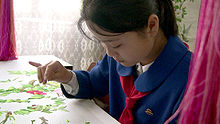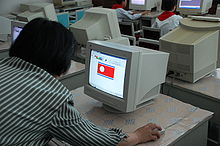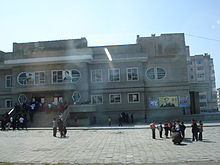- Education in North Korea
-
Education in the Democratic People's Republic of Korea (DPRK) is strictly controlled by the government. Children go through one year of kindergarten, four years of primary education, six years of secondary education, and then on to universities. The most prestigious university in the DPRK is Kim Il-sung University. Other notable universities include Kim Chaek University, which focuses on computer science, Pyongyang University of Foreign Studies, which trains working level diplomats and trade officials, and Kim Hyong Jik University, which trains teachers.
The Pyongyang University of Science and Technology, located just outside of Pyongyang city, started construction in 2001 and is largely funded by Korean and American Evangelical church groups. Its first class was scheduled to begin in 2003, although it has been delayed. Most recent announcements indicate that it might open in fall of 2010.[1]
Contents
History
Formal education has played a central role in the social and cultural development of both traditional Korea and contemporary North Korea. During the Joseon Dynasty, the royal court established a system of schools that taught Confucian subjects in the provinces as well as in four central secondary schools in the capital. There was no state-supported system of primary education. During the fifteenth century, state-supported schools declined in quality and were supplanted in importance by private academies, the seowon, centers of a Neo-Confucian revival in the sixteenth century. Higher education was provided by the Seonggyungwan, the Confucian national university, in Seoul. Its enrollment was limited to 200 students who had passed the lower civil service examinations and were preparing for the highest examinations.[2]
The late nineteenth and early twentieth centuries witnessed major educational changes. The seowon were abolished by the central government. Christian missionaries established modern schools that taught Western curricula. Among them was the first school for women, Ehwa Woman's University, established by American Methodist missionaries as a primary school in Seoul in 1886. During the last years of the dynasty, as many as 3,000 private schools that taught modern subjects to both sexes were founded by missionaries and others. Most of these schools were concentrated in the northern part of the country. After Japan annexed Korea in 1910, the colonial regime established an educational system with two goals: to give Koreans a minimal education designed to train them for subordinate roles in a modern economy and make them loyal subjects of the emperor; and to provide a higher quality education for Japanese expatriates who had settled in large numbers on the Korean Peninsula. The Japanese invested more resources in the latter, and opportunities for Koreans were severely limited. A state university modeled on Tokyo Imperial University was established in Seoul in 1923, but the number of Koreans allowed to study there never exceeded 40 percent of its enrollment; the rest of its students were Japanese. Private universities, including those established by missionaries such as Sungsil College in P'yongyang and Chosun Christian College in Seoul, provided other opportunities for Koreans desiring higher education.[3]
After the establishment of North Korea, an education system modeled largely on that of the Soviet Union was established. According to North Korean sources, at the time of North Korea's establishment, two-thirds of school-age children did not attend primary school, and most adults, numbering 2.3 million, were illiterate. In 1950 primary education became compulsory. The outbreak of the Korean War, however, delayed attainment of this goal; universal primary education was not achieved until 1956. By 1958 North Korean sources claimed that seven-year compulsory primary and secondary education had been implemented. In 1959 "state-financed universal education" was introduced in all schools; not only instruction and educational facilities, but also textbooks, uniforms, and room and board are provided to students without charge. By 1967 nine years of education became compulsory. In 1975 the compulsory eleven-year education system, which includes one year of preschool education and ten years of primary and secondary education, was implemented; that system remains in effect as of 1993. According to a 1983 speech given by Kim Il Sung to education ministers of nonaligned countries in P'yongyang, universal, compulsory higher education was to be introduced "in the near future." At that time, students had no school expenses; the state paid for the education of almost half of North Korea's population of 18.9 million.[4]
Primary and secondary education
In the early 1990s, the compulsory primary and secondary education system was divided into one year of kindergarten, four years of primary school (people's school) for ages six to nine, and six years of senior middle school (secondary school) for ages ten to fifteen. There are two years of kindergarten, for children aged four to six; only the second year (upper level kindergarten) is compulsory.
In the mid-1980s, there were 9,530 primary and secondary schools. After graduating from people's school, students enter either a regular secondary school or a special secondary school that concentrates on music, art, or foreign languages. These schools teach both their specialties and general subjects. The Mangyngdae Revolutionary Institute is an important special school.
In the early 1990s, graduation from the compulsory education system occurred at age sixteen. Eberstadt and Banister report that according to North Korean statistics released in the late 1980s, primary schools enrolled 1.49 million children in 1987; senior middle schools enrolled 2.66 million that same year. A comparison with the total number of children and youths in these age brackets shows that 96 percent of the age cohort is enrolled in the primary and secondary educational system.
School curricula in the early 1990s are balanced between academic and political subject matter. According to South Korean scholar Park Youngsoon, subjects such as Korean language, mathematics, physical education, drawing, and music constitute the bulk of instruction in people's schools; more than 8 percent of instruction is devoted to the "Great Kim Il Sung" and "Communist Morality." In senior middle schools, politically oriented subjects, including the "Great Kim Il Sung" and "Communist Morality" as well as "Communist Party Policy," comprise only 5.8 percent of instruction.[5]
Social education
Outside the formal structure of schools and classrooms is the extremely important "social education." This education includes not only extracurricular activities but also family life and the broadest range of human relationships within society. There is great sensitivity to the influence of the social environment on the growing child and its role in the development of his or her character. The ideal of social education is to provide a carefully controlled environment in which children are insulated from bad or unplanned influences. According to a North Korean official interviewed in 1990, "School education is not enough to turn the rising generation into men of knowledge, virtue, and physical fitness. After school, our children have many spare hours. So it's important to efficiently organize their afterschool education."
In his 1977 "Theses on Socialist Education," Kim Il Sung described the components of social education. In the Pioneer Corps and the Socialist Working Youth League (SWYL), young people learn the nature of collective and organizational life; some prepare for membership in the Korean Workers' Party. In students' and schoolchildren's halls and palaces, managed by the SWYL Central Committee, young people participate in many extracurricular activities after school. There are also cultural facilities such as libraries and museums, monuments and historical sites of the Korean revolution, and the mass media dedicated to serving the goals of social education. Huge, lavishly appointed "schoolchildren's palaces" with gymnasiums and theaters have been built in P'yongyang, Mangyngdae, and other sites. These palaces provide political lectures and seminars, debating contests, poetry recitals, and scientific forums. The Students' and Children's Palace in P'yongyang attracted some 10,000 children daily in the early 1990s.[6]
Higher education
Institutions of higher education include colleges and universities; teachers' training colleges, with a four-year course for preparing kindergarten, primary, and secondary instructors; colleges of advanced technology with two or three-year courses; medical schools with six-year courses; special colleges for science and engineering, art, music, and foreign languages; and military colleges and academies. Kim Il Sung's report to the Sixth Party Congress of the KWP in October 1980 revealed that there were 170 "higher learning institutions" and 480 "higher specialized schools" that year. In 1987 there were 220,000 students attending two- or three-year higher specialized schools and 301,000 students attending four- to sixyear colleges and university courses. According to Eberstadt and Banister, 13.7 percent of the population sixteen years of age or older was attending, or had graduated from, institutions of higher education in 1987-88. In 1988 the regime surpassed its target of producing "an army of 1.3 million intellectuals," graduates of higher education, a major step in the direction of achieving the often-stated goal of "intellectualization of the whole society."
Every university in North Korea has to receive certain percentage (twenty to thirty) of discharged soldiers (served longer than three years) or workers (employed longer than five years).[7]
Kim Il Sung University, founded in October 1946, is the country's only comprehensive institution of higher education offering bachelor's, master's, and doctoral degrees. It is an elite institution whose enrollment of 16,000 full- and part-time students in the early 1990s occupies, in the words of one observer, the "pinnacle of the North Korean educational and social system." Competition for admission is intense. According to a Korean-American scholar who visited the university in the early 1980s, only one student is admitted out of every five or six applicants. An important criterion for admission is senior middle school grades, although political criteria are also major factors in selection. A person wishing to gain acceptance to any institution of higher education has to be nominated by the local "college recommendation committee" before approval by county- and provincial-level committees.
Kim Il-Sung University's colleges and faculties include economics, history, philosophy, law, foreign languages and literature, geography, physics, mathematics, chemistry, nuclear power, biology, and computer science. There are about 3,000 faculty members, including teaching and research staff. All facilities are located on a modern, high-rise campus in the northern part of P'yongyang.
Choson Exchange, a non-profit organization founded by Harvard, Yale, Wharton School and Singaporean graduate students also runs consulting and training programs in Finance, Business and Economics with Kim Il Sung University and the State Development Bank in North Korea.[8] Their programs target North Koreans under the age of 40 and combine OpenCourseWare materials and on-site lectures to deliver year-round training.
Pyongyang University of Science and Technology (PUST), scheduled to open in 2008, is the country's only joint venture institute of higher learning, founded, funded and operated by Evangelical Church groups and people from both North and South Korea, as well as China and the USA. It plans to recruit around 200 Master and PhD level students annually, from both Koreas, and with half of faculty hired from universities and research institutes abroad. At this university, courses will be taught in Korean and English. In addition, the Pyongyang Business School offers short courses given by foreign lecturers.[9]
Adult education
Because of the emphasis on the continued education of all members of society, adult or work-study education is actively supported. Practically everyone in the country participates in some educational activity, usually in the form of "small study groups." In the 1980s, the adult literacy rate was estimated at 99 percent.[10]
In the early 1990s, people in rural areas were organized into "five-family teams." These teams have educational and surveillance functions; the teams are the responsibility of a schoolteacher or other intellectual, each one being in charge of several such teams. Office and factory workers have two-hour "study sessions" after work each day on both political and technical subjects.
Adult education institutions in the early 1990s included "factory colleges", which teach workers new skills and techniques without forcing them to quit their jobs. Students work part-time, study in the evening, or take short intensive courses, leaving their workplaces for only a month or so. There are also "farm colleges", where rural workers can study to become engineers and assistant engineers, and a system of correspondence courses. For workers and peasants who are unable to receive regular school education, there are "laborers' schools" and "laborers' senior middle schools," although in the early 1990s these had become less important with the introduction of compulsory eleven-year education.
See also
References
- ^ http://yuldo.net/asian-eng/abstracts/seminar-23-fouser.pdf>
- ^ http://education.stateuniversity.com/pages/1116/North-Korea-HIGHER-EDUCATION.html>
- ^ http://countrystudies.us/north-korea/42.htm>
- ^ http://www.bookrags.com/research/north-koreaeducation-system-ema-04/>
- ^ http://www.dailynk.com/english/read.php?cataId=nk00100&num=2653>
- ^ http://www.britannica.com/EBchecked/topic/322222/North-Korea/34939/Education>
- ^ NK Watch
- ^ "Choson Exchange". http://chosonexchange.org/.
- ^ http://blogs.nature.com/news/thegreatbeyond/2010/02/the_long_road_to_higher_educat_1.html>
- ^ http://data.worldbank.org/country/korea-democratic-republic
External links
- Pyongyang Business School website
- Pyongyang University of Science and Technology website
- Choson Exchange website
States with limited
recognition- Abkhazia
- Nagorno-Karabakh
- Northern Cyprus
- Palestine
- Republic of China (Taiwan)
- South Ossetia
Dependencies and
other territoriesCategories:
Wikimedia Foundation. 2010.



